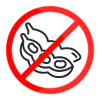










purebulkinc
Copper Gluconate Powder Pure
Customers Who Bought This Item Also Bought
Tested By Accredited 3rd Party Labs
PureBulk's supplements are tested by accredited third party labs in the USA to ensure their identity, purity and potency. To receive a copy of these test results or any other PureBulk supplement please fill out the COA request form found here.
*NOTE: These statements have not been evaluated by the Food and Drug Administration. This product is not intended to diagnose, treat, cure or prevent any disease.
What is Copper Gluconate Pure?
Copper is the third most abundant trace mineral in the human body, and it is essential for all aerobic organisms (i.e., requires oxygen). Copper gluconate is an orally bioavailable copper salt derived from D-gluconic acid. Gluconic acid is a nontoxic and mild organic acid. It regulates acidity and inhibits bitterness in many foods and beverages, such as wine. It has a refreshing taste that starts slightly sweet and ends with a slight acidity.
What Does Copper Do for the Body?
Copper plays a vital role in several physiological and biochemical metabolic pathways and is a cofactor for metalloenzymes (metal-containing enzymes). Copper helps the body grow, maintain, and develop connective tissues, bones, and numerous organs. It also plays a role in red blood cell production, iron absorption, and stimulating the immune system.
What Foods Have Copper?
The most copper-rich foods include organ meats, shellfish, seeds, nuts, whole grains, and some vegetables. Specific copper-rich foods include:
- Beef liver
- Oysters
- Alaskan king crab
- Blue crab
- Clams
- Cashews
- Sunflower seeds
- Lentils
- Hazelnuts
Copper Deficiency Symptoms
While a true copper deficiency is rare, up to 25% of North America falls short of the recommended daily intake. Certain conditions make individuals more prone to copper deficiencies, such as celiac disease, bariatric surgery, and other procedures that affect digestion. Copper also competes with zinc for absorption in the digestive tract, and a diet that is rich in one may cause a deficiency in the other. Taking too much iron can also reduce copper’s availability. Some common copper deficiency symptoms include:
- Fatigue
- Weak bones
- Frequent illness
- Memory problems
- Prematurely greying hair
- Loss of coordination or an unsteady gait
- Pale skin
- Cold intolerance
- Vision problems
Potential Copper Supplement Benefits
Copper as an Antioxidant
One of copper’s most important functions is catalyzing reduction and oxidation (REDOX) reactions that are vital for energy production, synthesizing melanin, and cross-linking collagen. Copper is also a critical component of superoxide dismutase, an antioxidant that detoxifies free radicals like superoxide anion. Copper also supports general health and wellbeing by developing and maintaining the immune system.
Copper for Energy
Copper also contributes to energy production by catalyzing the enzyme cytochrome c oxidase, a copper-dependent enzyme that is essential for energy production. Copper helps the enzyme reduce oxygen molecules into water, generating an electrical charge that the mitochondria use to generate adenosine triphosphate (ATP) and store energy.
Copper and Iron Metabolism
Other copper enzymes, known as multi-copper oxidases (MCO), aid iron metabolism and red blood cell formation. MCOs oxidize iron into a transportable form that transferrin proteins then deliver to red blood cells. Copper also helps the body utilize and absorb iron efficiently. Insufficient copper can lead to anemia, as the body can’t produce enough red blood cells without it.
Copper and Cognition
Copper helps protect the brain and nervous system by synthesizing the phospholipids found in nerves and their protective myelin sheaths. It also catalyzes cuproenzymes that the brain needs to function. Copper also helps convert dopamine into norepinephrine, a neurotransmitter that affects alertness, attention, memory, sleep, and mood.
Copper and Aesthetics
Copper works with vitamin C and zinc to help make tissue proteins, collagen, and a component of connective tissue known as elastin. Copper also helps manage and control the function of lysyl oxidase, an enzyme responsible for the creation of collagen in the bones, connective tissues, and skin. These functions are essential for the development and maintenance of healthy and youthful-looking skin. Many topical creams designed to firm and restore skin elasticity now contain copper peptides as an active ingredient. The body needs copper to help produce the skin pigment melanin, which colors the skin, hair, and eyes. When hair becomes gray due to copper deficiency, copper supplementation may help reverse the process.
Potential Copper Supplement Side Effects
Copper can be TOXIC if taken in excess. More than 4 milligrams of pure copper per day may cause nausea or muscle pain. In severe cases, it may result in liver damage, kidney failure, coma, or death. Symptoms of acute copper toxicity include abdominal pain, nausea, vomiting, and diarrhea. Other possible side effects include muscle and joint pain, nervousness, irritability, or depression.
Supplemental copper is contraindicated in those with Wilson's disease (hepatolenticular degeneration), a disease of abnormal copper accumulation. Copper may interact with prescription and nonprescription medications. Consuming too much copper can reduce zinc and vitamin C levels and vice versa. Consult with a physician before starting any new supplement.
Purity and Concentration of Copper Gluconate
PureBulk’s copper gluconate anhydrous contains no fillers or additives. The compound Copper Gluconate contains 14% elemental copper by weight.
Copper ≥13%
Gluconic Acid ≥80%
*For current test results, please request a Certificate of Analysis.
References & Further Research
- https://ods.od.nih.gov/factsheets/Copper-Consumer
- https://pubchem.ncbi.nlm.nih.gov/compound/Copper-gluconate
- https://www.ncbi.nlm.nih.gov/pubmed/2191491
- https://www.ncbi.nlm.nih.gov/pubmed/25057538
- https://www.ncbi.nlm.nih.gov/pubmed/20211248
- https://www.ncbi.nlm.nih.gov/pubmed/6316150
- https://www.ncbi.nlm.nih.gov/pubmed/6646211
- https://www.ncbi.nlm.nih.gov/pubmed/3301253
- https://www.ncbi.nlm.nih.gov/pubmed/3472455
- https://www.ncbi.nlm.nih.gov/pubmed/9587153
- https://www.ncbi.nlm.nih.gov/pubmed/13859394
- http://www.ncbi.nlm.nih.gov/pubmed/9587135
- https://www.sciencedirect.com/science/article/pii/S0946672X11002355
- http://www.ncbi.nlm.nih.gov/pubmed/23807651
- http://www.jbc.org/content/77/2/797.short
- https://www.ncbi.nlm.nih.gov/pubmed/11570430https://www.ncbi.nlm.nih.gov/pubmed/15762288
- https://www.ncbi.nlm.nih.gov/pubmed/16629178
- https://newscenter.lbl.gov/2013/05/24/copper-on-the-brain/
- https://www.ncbi.nlm.nih.gov/pubmed/21979243
- https://www.ncbi.nlm.nih.gov/pubmed/23974581
















